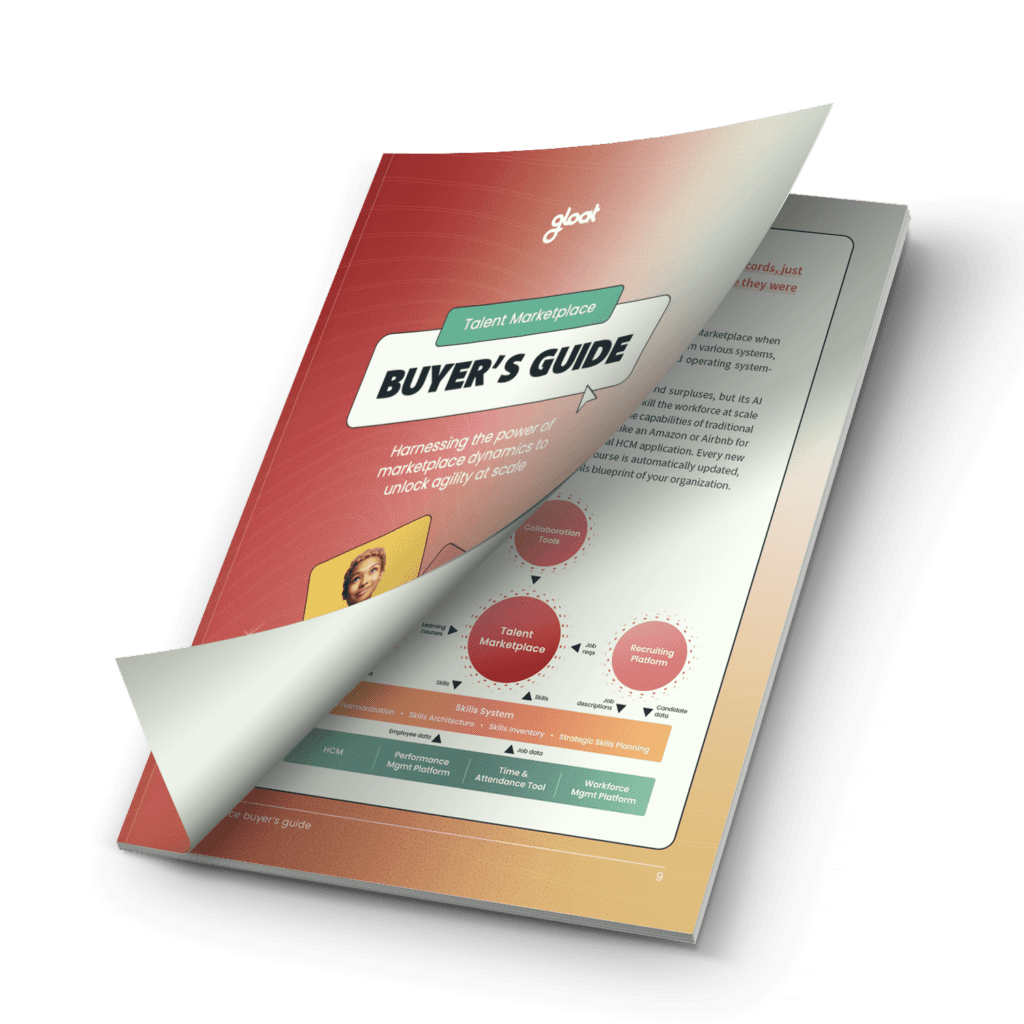Breaking the traditional mold: internal talent marketplace success stories
Behind-the-scenes with HSBC, Mastercard, & Seagate during their talent marketplace journeys

Every organization is looking for an edge that will set them apart from the competition in 2024—and many are counting on talent marketplaces to give them that advantage. As our research with The Josh Bersin Company reveals, the new goal for business and HR strategy is embracing dynamic ways of working.
Dynamic Organizations are 3X more likely to meet financial targets and 5X more likely to adapt to change well. Unsurprisingly, these elite companies are also talent marketplace super users; overall, Dynamic Organizations are 51X more likely to use this technology than their static counterparts are.
Given that talent marketplaces can seamlessly match employees to open opportunities across the enterprise based on skills and capacity, it’s easy to understand why these platforms are such powerful tools for becoming more dynamic. If you’re looking to help your organization stay ahead of the competition in 2024, we’ve got a few tips to guide you through every step of your talent marketplace journey—as well as some best practices from organizations that have implemented them successfully.
What is an internal talent marketplace?
Unlike traditional HR technology, talent marketplaces harness the power of AI to dynamically align employees to projects, gigs, mentorships, and full-time roles within their organizations. Much like Uber manages the supply and demand of riders and cars, the talent marketplace does the same thing for skills and opportunities. It uses marketplace dynamics to transform the way we work, giving leaders on-demand access to qualified candidates who can be deployed to projects as new challenges arise and priorities shift.
5 benefits of launching an internal talent marketplace
There are several benefits associated with launching an internal talent marketplace, including:
#1. Adapt to emerging challenges effectively
Amidst ongoing market uncertainty and the rapid rise of AI, every business can feel confident that they will need to continue to keep their fingers on the pulse to ensure they’re capitalizing on the latest technological advances. After emerging as a do-or-die priority during the COVID-19 pandemic, agility will become even more important as the pace of change continues to accelerate.
While nine out of ten executives believe organizational agility is critical to business success, most leaders don’t have what they need to unlock it. Namely, they lack full visibility into workforce skills, preventing them from redeploying talent at a moment’s notice to meet evolving priorities. Talent marketplaces put these rapid pivots and fast-paced redeployments well within reach.
#2. Break down silos
Traditional rigid hierarchies are a recipe for organizational silos. When employees only know what’s happening within their department, knowledge remains trapped within various segments of the business. Employees’ skills will only be put to use within their teams, in turn preventing other departments from capitalizing on this expertise.
While inefficiencies caused by silos typically cause companies to lose 20-30 percent in revenue annually, some organizations are using talent marketplaces to empower employees to share their skills. Workers can collaborate cross-functionally, lend a hand when they have extra capacity, and come together to help your enterprise achieve performance goals that may have once seemed out of reach.
#3. Improve engagement and retention
If your people don’t see a future with your organization, they’re likely to build one somewhere else—which is bad news for your bottom line. The cost of replacing an individual employee can range from one-half to two times their annual salary and overall, turnover costs businesses $600 billion annually.
For a long time, many employees felt stuck in their careers because they believed that vertical progression was the only direction they could go in. However, with help from a talent marketplace, workers can expand their horizons by pursuing lateral career opportunities that enable them to build new skills while fulfilling business needs.
#4. Empower employees to build in-demand skills
Since the World Economic Forum predicts that 50% of the workforce will need reskilling by 2025, the clock is ticking when it comes to building future-fit skills. In the past, L&D initiatives often failed to make an impact because they were missing a critical piece of the puzzle: experiential learning.
To maximize the efficacy of your skill-building strategy employees need the chance to put what they’re learning into practice. Talent marketplaces take training and development to the next level by matching people to projects, gigs, and mentorships that will provide the hands-on experience that was once lacking.
#5. Make opportunities accessible to all
In addition to the benefits above, talent marketplaces are a powerful tool for breaking down barriers and democratizing career development. A recent survey of 400 tech executives indicates that talent marketplaces have significant potential to achieve successful diversity, equity, and inclusion outcomes. Furthermore, more diverse businesses tend to benefit from higher levels of employee engagement.
Rather than letting potentially bias-inducing factors such as geographic proximity and personal networking sway career mobility decisions, talent marketplaces harness ethically constructed AI to level the playing field. The internal candidates that the platforms suggests are recommended based on their skills and experiences, and little else. As a result, talent marketplaces can surface qualified employees who may have once been overlooked.
3 best practices for a seamless talent marketplace implementation
There are a few steps you can take to maximize the success of your forthcoming talent marketplace, including:
#1. Be clear about your talent marketplace vision
Launching a talent marketplace isn’t the same as updating your human capital management platform or adding new features to an existing system, as Josh Bersin explains. “It’s not just a set of features on your ERP. This is an application that operates differently, with different data sources and different kinds of functionality. It has to have a particularly unique user experience and it has to be very user-centric.”
Consequently, leaders need a clear vision of what their integrated talent marketplace system will look like. Before launching your platform, make sure you have answers to the following questions:
- How do we want to integrate technologies across the ecosystem to create value for our organization?
- How can we create a seamless user experience for our people?
- Are we going to select a one-size-fits-all suite or go with an open platform approach?
- Is the platform scalable?
- Have other companies implemented it successfully?
- What is the product built to do?
- What kind of internal opportunities will users be able to access?
- Are change and enablement help included?
#2. Get leader and manager buy-in from the start
The most effective way to get everyone on board with your talent marketplace vision is by gaining the support of your leadership team. As executives embrace your launch plan, encourage them to share why they’re excited about the platform and spotlight the tangible benefits it will help you achieve. Nestlé USA’s CEO even created a welcome video that played during an employee’s first visit to their talent marketplace to get people excited about their new platform.
Middle managers can be one of the most difficult populations to engage during your talent marketplace launch, as they may hesitate to let go of top-performing workers out of fear that they’re losing control in the transition. It’s critical to brief this group early on and demonstrate how the solution will benefit them by enabling their direct reports to grow and expand their skill sets.
#3. Choose your change team
Implementing a talent marketplace isn’t just about learning a new technology; it’s also about embracing an entirely new approach to work that’s rooted in skills and employee ambitions. Selecting a Change and Enablement lead to manage the implementation process is pivotal to achieving success, as they will be the ones supporting teams throughout the journey. Additionally, leaders need to make sure that communications and training resources are engaging to ensure employees will have content to guide them as they get familiar with their new platform.
3 examples of successful talent marketplace implementations
If you’re searching for role models to inspire your talent marketplace launch, look no further: here are three organizations that have used their platforms to drive high-impact talent transformations.
HSBC
With more than 40 million customers relying on their financial services, HSBC wanted to ensure its workforce had the capabilities needed to thrive in the new world of work. Leaders sought to develop a future-fit upskilling strategy that would break down silos, unlock potential, and fuel meaningful career development.
The organization decided to launch a talent marketplace to replace boundaries with internal mobility and create a launching pad for the next chapter of work. In addition to using the platform to empower employees to take on new projects and experiential learning opportunities, leaders also harness the data and insights the solution provides. All of the integrated data from the marketplace provides foundational workforce intelligence to inform strategic planning decisions and drive the next steps in HSBC’s dynamic transformation.
In describing the impact of their talent marketplace launch, former Group Head of Resourcing Hamish Nesbit says, “The idea that we now know with greater certainty, what skills sit where and what aims people have gives us a much stronger platform to think about increasing our internal mobility, which in turn retains our global corporate knowledge and builds employee engagement as they start to understand that more and more of their goals and ambitions can be realized within HSBC.”
Mastercard
During the early days of the pandemic, Mastercard began matching employees to high-priority tasks through an internal initiative known as Project Possible. After recognizing the immense value of an employee-led approach to career development, the company decided to launch a talent marketplace to scale up its internal mobility initiative so all employees could participate
As their Chief Human Resources Officer Michael Fraccaro notes, “We saw the start of this internal talent marketplace where people were willing to utilize some of their time—10%, 20%, or 30%—to actually work on things in adjacent businesses or functions. And that has been a real eye-opener, which is why we are partnering with Gloat, because we see this at a macro level and we see this as part of the future of work as well.” To date, the global payments technology leader has saved $21 million through their internal mobility initiative and unlocked over 100,000 hours of capacity.
Seagate
Rather than looking to external hires to support shifting priorities, Seagate embarked on a large-scale redeployment underpinned by their talent marketplace. Within the first four months of launching their platform, the data storage leader estimated that they had saved $1.4 million—and that was just the beginning.
Building on their success, Seagate’s Global Directory of Talent Agility Divkiran Kathuria shares that today, “… we have over 58,000 hours that have been unlocked and over 50% of [our talent marketplace} projects are cross-entity. We have a productivity savings of about $1.6 million. And in terms of diversity and inclusion, we found that 1.4X more women apply to these opportunities compared to men and 1.7X more is their chance to get converted to an assignment compared to men.”
If you’re looking to make the most of your talent marketplace journey, check out our buyer’s guide to ensure you choose a platform that aligns with your business needs.





